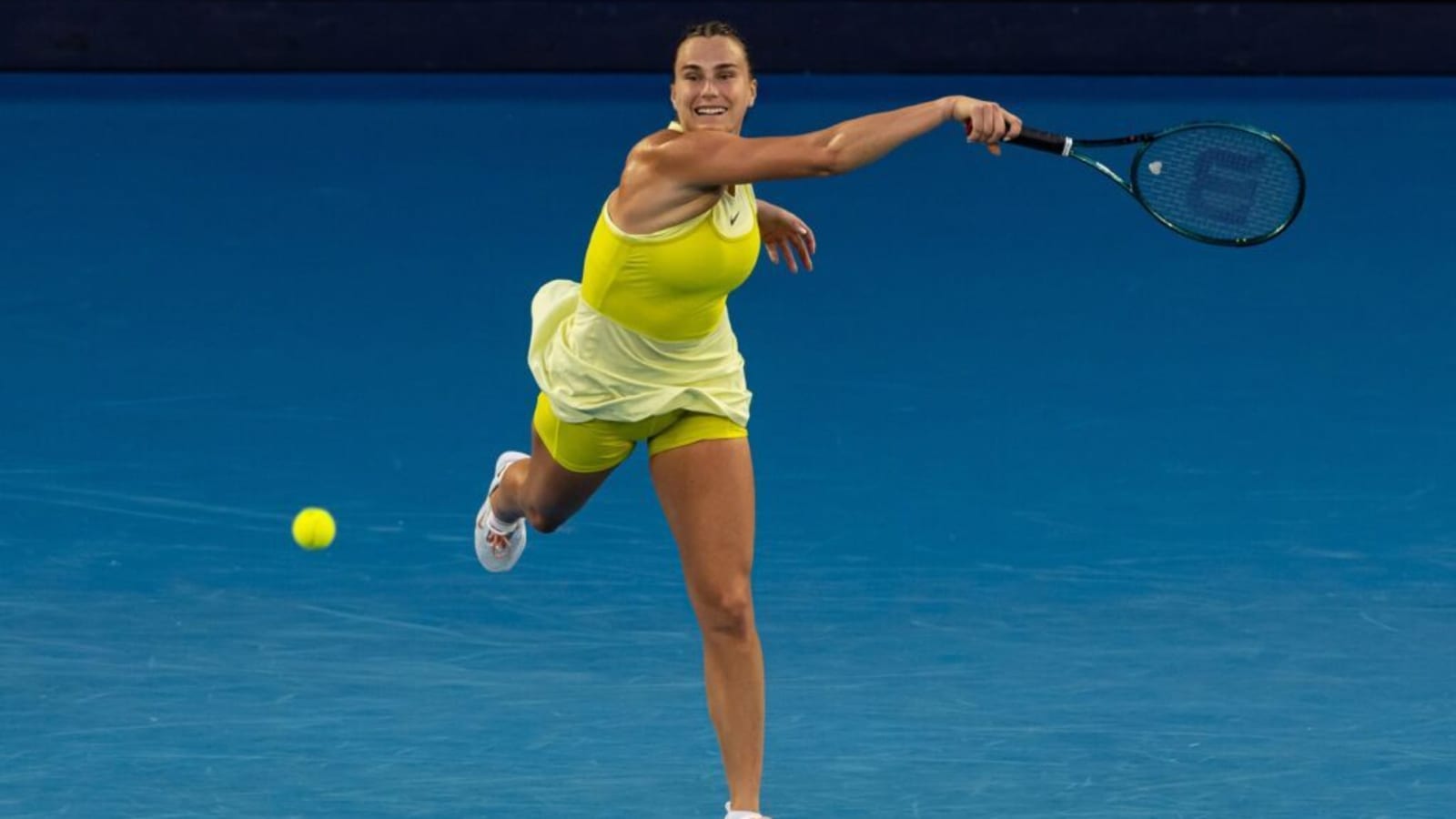
Three is obviously the magic number in Australia this year. In addition to the three-day opening round (which at least will prevent any backlog of matches building up after the rain-affected first day), Aryna Sabalenka, the defending women’s singles champion, is attempting to “threepeat” by winning a third Australian Open title in succession.
What are Sabalenka’s chances? And who are the seven women before her to complete a hat-trick of Australian titles?
Can Aryna Sabalenka make it a hat-trick of Australian Opens?
Aryna Sabalenka’s Chances of the Threepeat
Aryna Sabalenka is undeniably the current queen of hardcourt tennis, having won the two previous Australian Opens in 2023 and 2024 and also triumphed at the US Open last autumn. Iga Świątek may continue to reign on clay, having already achieved a Roland Garros threepeat (and won four titles in the last five years), but Sabalenka has established herself as the dominant female player on hard courts and that alone has been sufficient for her to supplant Świątek as World #1.
Indeed, so dominant has the Belarussian become on hardcourt that it is hard to believe that she only won her first Major two years ago. Before then, she had been long-tipped to become a Grand Slam champion, but a combination of nerves and serving issues seemed to prevent her from ever going deep in a Major, let alone winning one.
Now, however, the picture is completely different. Sabalenka has learned how to control both her nerves and her serves, such that she has become virtually unbeatable on hardcourt, especially in Melbourne. Notwithstanding the challenge of Coco Gauff in particular, who she is seeded to meet in the semifinal, she looks an extremely good bet to win a third Australian Open title in succession. She certainly looks more likely to threepeat than the other great sporting force trying for a hat-trick of titles in early 2025, namely the Kansas City Chiefs, who are bidding to become the first NFL team to win three Super Bowls in succession.
And if Sabalenka does complete her hat-trick in Melbroune, she will join a very exclusive club of women who have won at least three titles in succession in Australia.
The Previous “Threepeaters” (in Chronological Order)
1.Daphne Akhurst (Threepeat 1928-1930, and five Australian titles in total)
The first woman to win three Australian Women’s Singles titles in succession was the woman who the Women’s Singles trophy is now named after – Daphne Akhurst. Tragically, Akhurst died in 1933, at the extremely young age of just 29, from an ectopic pregnancy.
Unlike all the other Majors, the Australian Championships (or, to use its original title, the Australasian Championships) did not have a Women’s Singles event when it began in 1905. Indeed, it was nearly 20 years before there was a Women’s event and in that first decade of female competition Akhurst was the dominant force, winning the tournament five times in total and three times in a row between 1928 and 1930.
However, having retired from top-level tennis in 1931 to marry, Akhurst was dead within two years. In tribute to her on-court excellence and her pioneering role in promoting women’s tennis, especially in Australia, the Women’s Singles trophy was renamed in 1934 the Daphne Akhurst Memorial Cup, which continues to be played for to this day.
-
Nancye Wynne Bolton (1946-48, and six Australian titles in total)
After Akhurst’s tragically early death, another Australian woman emerged to replace her as the main force in the Australian Championship which, before the invention of jet travel, was a largely Australian-dominated event. That was Nancy Wynne Bolton, who won a hat-trick of titles between 1946 and 1948, and six titles in total, putting her third on the all-time list of multiple Australian Open women’s champions behind only Margaret Court (with 11 titles) and Serena Williams (with seven).
Wynne Bolton won her first two Australian titles in 1937 and 1940, when the tournament was suspended for the rest of World War Two. Notwithstanding the subsequent five-year gap between Australian Championships, she was even more successful after the end of World War Two, winning the first three editions of the tournament after it resumed in 1946 and adding a fourth post-war title (and sixth in total) in 1951.
-
Margaret Court (1960-66, and 11 titles in total)
Until Rafael Nadal’s recent near-annexation of Roland Garros, where he won a truly remarkable 14 titles between 2005 and 2022, no tennis player of either gender had ever dominated a Major like Margaret Court (née Smith). Between 1960, when she won her first Australian title, and 1977, when she retired, she won 11 Australian titles in total, including seven titles in a row between 1960 and 1966 and, for good measure, a further hat-trick of titles between 1969 and 1971. In other words, her domination of her home Major encompassed both the Amateur and the Open eras of tennis.
Since her retirement and her descent into extreme “Christianity”, which famously includes the homophobia and transphobia that has prompted calls for the Margaret Court Arena (which had been named in her honour) in Melbourne to be renamed, it has been tempting at times to dismiss Court’s monumental on-court achievements. However, as one of her most prominent critics, Martina Navratilova, famously said in 2017, for all that she is a “homophobe” (and probable “racist” to boot) Court was always “an amazing tennis player”.
-
Evonne Goolagong (1974 to 1976, and four titles in total)
The woman whose name Navratilova and others would like to replace that of Court on Melbourne’s second main arena is Evonne Goolagong, Court’s successor as the greatest Australian female player, and in so many ways her complete antithesis as both a player and a human being. Unlike the WASPy and ultimately rather repellent Court, Goolagong was an indigenous Australian or Aboriginal, and the most charming and empathetic of people. That was demonstrated again in 2022 when she presented the winner’s trophy to Ash Barty, who herself is partly of indigenous Australian or Aboriginal descent.
Goolagong achieved her Australian Open hat-trick between 1974 and 1976, which included victories over a young Chris Evert and Martina Navratilova in the 1974 and 1975 finals respectively. She won the title again in 1977, but did not achieve a “four-peat”, as it were, because there were actually two Australian Opens that year, in one of the many scheduling quirks that affected the tournament until it settled on a January start in the mid-1980s. Goolagong missed the January 1977 edition of the tournament, because she was pregnant, but soon after giving birth she returned to win the December 1977 version.
-
Steffi Graf (1988-90, and four titles in total)
The first four women on this list are all Australian, whereas the final three are all not Australian, which neatly demonstrates how the Australian Championship (or Australian Open, as it has been since 1968) has developed over time from an almost exclusively Australian-dominated event to one that is far more multinational in scope.
The first of the three non-Australian “threepeaters” so far was Steffi Graf, whose first Australian Open title came in her greatest year of 1988, when she won the Calendar Slam and the Olympic Singles title to achieve The Golden Slam. She could not quite maintain that total dominance of women’s tennis thereafter, but among her many other subsequent achievements she won the next two Australian Open titles in succession and added a fourth Australian title in 1994.
-
Monica Seles (1991-1993, and four titles in total)
Graf’s greatest rival throughout her career was not Martina Navratilova, whose own career was coming to an end as Graf’s was beginning, but Monica Seles, the teenage Yugoslavian prodigy who emerged to challenge Graf’s domination of women’s tennis in the early 1990s. Having already won the French Open in 1990, Seles won her first Australian Open in 1991, and won the next two Australian titles in succession as well, beating Graf in the 1993 final.
Nevertheless, for all her greatness in winning a hat-trick of Australian Open titles at the start of the 1990s, it is Seles’s fourth Australian Open title in 1996 that is her most impressive, because it is arguably the single most impressive Grand Slam Singles title in history by any tennis player, male or female. That, of course, is because it came after she had been stabbed on court in Hamburg in 1993 by a demented Steffi Graf “fan”. That she returned to court at all was impressive; that she ended up winning yet another Major was extraordinary.
-
Martina Hingis (1997-99)
The last woman to win three Australian Open Women’s Singles titles in succession was Martina Hingis, the second great tennis-playing “Martina” after Navratilova. For a period at the end of the last century, before the full emergence of the Williams sisters, the teenaged Hingis was a genuine phenomenon, winning five Majors in total, including a hat-trick of titles in Melbourne.
Remarkably, Hingis ended up achieving another hat-trick in Melbourne, but it was an unwanted one, as she reached three more finals in succession between 2000 and 2002, but lost them all: the first one to Lindsay Davenport; and the next two to a rejuvenated Jennifer Capriati. And finally the full flowering of the Williams sisters meant that her brief domination of women’s tennis, particularly in Australia, came to an end, but not before she had reached six Australian Open women’s singles finals in succession.
More must-reads:
- Clemson HC Dabo Swinney fumes over college football officiating, calls for 'accountability'
- Kevin Durant, Draymond Green argue over Warriors' titles, and they're both right
- The 'World Series MVPs' quiz
Breaking News
Trending News
Customize Your Newsletter
 +
+
Get the latest news and rumors, customized to your favorite sports and teams. Emailed daily. Always free!








